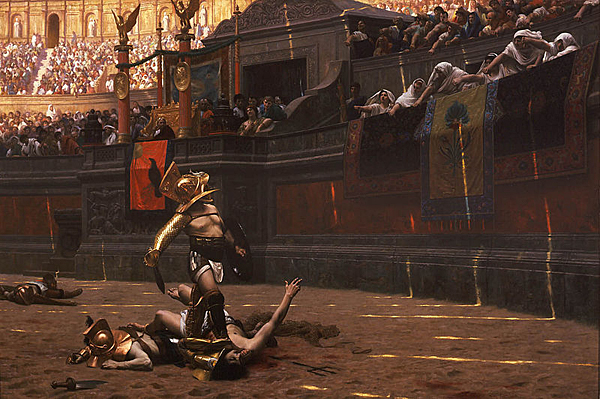
The Imperial Eagle, a Symbol of the Roman Empire. SPQR stands for “Senatus Populusque Romanus” which means “The Senate and People of Rome.”
For my first post on this “Empire of the Week” blog, I feel obligated to cover the most widely known and culturally influential empire in history: The Roman Empire. The story of this sprawling civilization has a humble beginning. I could tell you that the city was founded as a result of the interactions of native Latin peoples and Etruscans who brought Greek culture from the coast, but that’s boring. Around 750 BC, according to legend, the twin brothers Romulus and Remus (who were, by the way, raised by WOLVES) founded a city atop the Palatine Hill in central Italy that would come to be known as Rome. Romulus took control after he or one of his henchmen killed his brother Remus, and got to work creating a city. He attracted refugees, as well as gave refuge to criminals in order to grow the population, and he kidnapped a bunch of Sabine women to be brides for himself and the rest of the scum and villainy who followed him. Following Romulus were a slew of kings who had absolute power and were advised by the Roman Senate which was weak at that point.

An Artistic Representation of the Roman Senate
After years of oppression by despotic kings, the citizens of Rome had enough. In 510 BC the nobles revolted against King Tarquin, and after a series of bloody wars, they were able to create the Roman Republic. One of the greatest innovations of their system of government was equal protection under the law for all Roman citizens. The definition of citizen changed over time, first being limited to male descendants of the original Latin tribes who founded Rome. Later, allies of Rome were given citizenship and finally in 212 AD all free people in the Empire could become citizens. Those who held citizenship could vote. practice commerce, and marry, as opposed to slaves who basically had no rights until they were free. During the Republic, the leadership of the nation was the Senate, composed of patricians (big shot nobles) who created laws, debated issues, and elected consuls to act as chief executives. The Senate’s power increased steadily after the fall of the last Etruscan king until a man named Julius Caesar came along.

The Furthest Extent of the Roman Empire
Julius Caesar rose to power during a time when the Roman military was supreme. Generals led legions of thousands of men into battle all across the known world, from Britain to Egypt, and gained the loyalty of their soldiers through heroic feats, rousing speeches, and by giving them essentially free food, room, and board (a better deal than college). Caesar was one of these renowned generals who shut down barbarian revolts in Gaul, gave farmers tax breaks in Rome, and was a tremendously popular guy. When the Roman Senate removed him from his post as governor of the province of Gaul, he marched down to Rome with his army and seized power for himself. He held power as dictator of Rome, defeating challengers to his authority and reforming the system until he was murdered on the ides of March by a group of senators. However, this did not lead to the restoration of the Republic but instead to another civil war that was eventually won by Caesar’s adopted heir Octavian, who doubled down on Caesar’s dictatorial power and completed the transformation of the Republic into an Empire. This Roman Empire went on to conquer ridiculous amounts of land, erect grand monuments, create revolutionary legal systems, unite vastly diverse groups under one banner, and, although it fell to barbarians in 476 AD, become a legendary influence for the rest of the history of the world.

An Artistic Representation of Gladiatorial Combat in Ancient Rome
Despite all of the grandeur of the Roman Empire, it had a dark underbelly. The expansion of the empire across the Mediterranean Coast and beyond involved vast bloody wars, brutal massacres, assassinations, and all kinds of internal strife. Religions such as an infant Christianity were brutally persecuted at times and the cult of emperor worship was viciously enforced. Slave labor was a large portion of Roman society, and most slaves did not have a chance to become citizens and gain rights in the eyes of the law. For entertainment, Romans watched captives fight each other and animals in brutal, gory, gladiatorial combat just as Americans watch football on the weekends. Even in the revolutionary legal system, there were some terrible laws mandating the murder of deformed babies when they were born, as well as the implementation of sadistic execution techniques, the most popular of which was crucifixion.

The Pantheon Today (looks pretty good for something 1,890 years old)
Today, Rome’s legacy can be seen in numerous ways. Coliseums, temples, and senate buildings can be seen everywhere from Tunisia to Turkey, and national capitals and courthouses across the globe are constructed with architecture similar to that of the Pantheon and other ancient marvels. Modern languages including Spanish, Portuguese, French, Italian, Romanian, and Catalan (a really obscure language I forgot existed) all have their origins in Latin, the official language of the Roman Empire. The judicial system in the western world is built upon the court system of the Roman Empire, with the idea of “innocent until proven guilty” originating from the Imperial court. In universities like Penn State, the techniques of Roman orators such as Cicero, the theatrical productions of Terence, and the philosophies of Marcus Aurelius are still studied to this day and can be applied to help discuss and address complex issues in the modern world. In a certain way, the Roman Empire continues to exert tremendous influence over the world, and it will continue to for many centuries to come.
Sources (if you want more information):
http://www.danxner.com/extramaterials/art003/Final_Project/Influences.htm
http://www.roman-empire.net/index.html
http://www.ushistory.org/civ/6a.asp
http://www.history.com/this-day-in-history/rome-founded
http://www.ancient.eu/Roman_Empire/